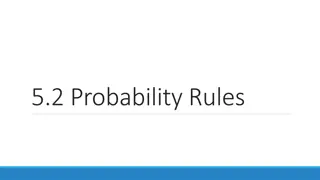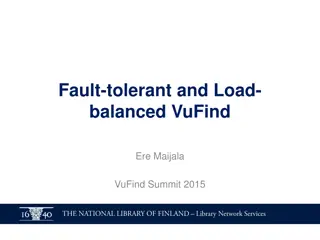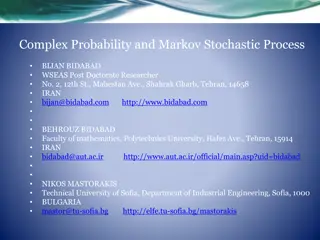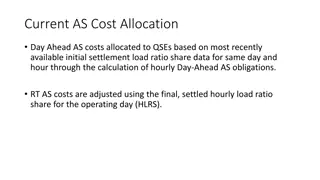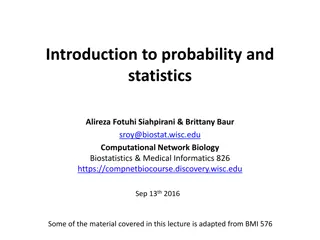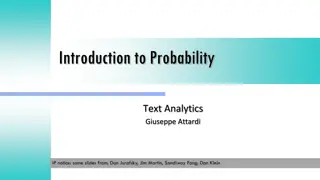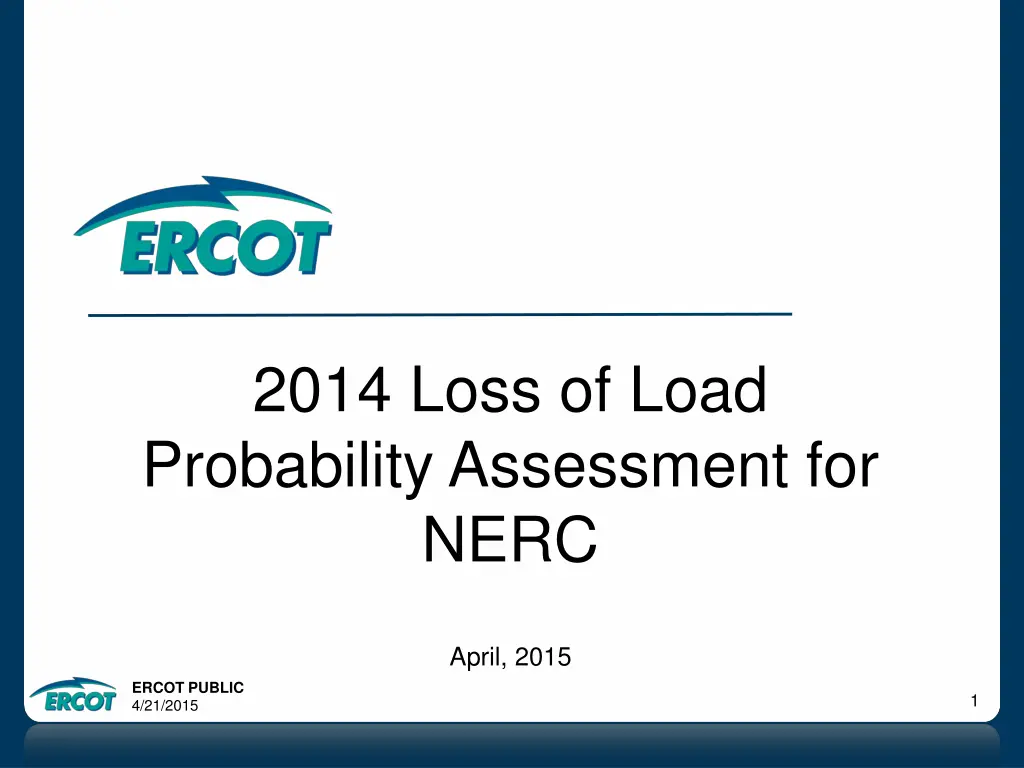
Probability Assessment for NERC 2014: Reliability Metrics & Modeling Study
Explore the 2014 Loss of Load Probability Assessment for NERC, focusing on the probabilistic risk assessment, modeling assumptions, and reliability metrics derived. The study fulfills NERC requirements, with a multi-zone study topology and probabilistic modeling methodology analyzed for load growth uncertainty. Discover the general assumptions, multi-weather-year analysis, and economic load growth factors considered in the study.
Uploaded on | 0 Views
Download Presentation

Please find below an Image/Link to download the presentation.
The content on the website is provided AS IS for your information and personal use only. It may not be sold, licensed, or shared on other websites without obtaining consent from the author. If you encounter any issues during the download, it is possible that the publisher has removed the file from their server.
You are allowed to download the files provided on this website for personal or commercial use, subject to the condition that they are used lawfully. All files are the property of their respective owners.
The content on the website is provided AS IS for your information and personal use only. It may not be sold, licensed, or shared on other websites without obtaining consent from the author.
E N D
Presentation Transcript
2014 Loss of Load Probability Assessment for NERC April, 2015 ERCOT PUBLIC 4/21/2015 1
Outline Background Modeling Assumptions Multi-zone Study Topology Probabilistic Modeling Methodology Results ERCOT PUBLIC 4/21/2015 2
Background The study fulfills the NERC requirement to perform a Probabilistic Risk Assessment in association with the annual Long Term Reliability Assessment (LTRA). Purpose of the study is to derive reliability metrics including Expected Unserved Energy (EUE) and Loss of Load Hours (LOLH) for the years 2016 and 2018. The study is not intended to determine a target or minimum planning reserve margin such as required in the Protocols. Adopted the modeling framework and assumptions used for the Brattle EORM study Modeling performed by Astrape Consulting using their reliability analysis and hourly production cost system, SERVM (Strategic Energy & Risk Valuation Model) ERCOT PUBLIC 4/21/2015 3
General Assumptions Loads/resources based on May 2014 CDR Energy-Limited Resource Modeling PUNS, Demand Response, Price-responsive Demand (PRD), Hydro all modeled based on January 2014 EORM Study methodology; however, capacities were updated. Historical market prices and response magnitudes were used to develop an appropriate supply curve for PUNs and PRD classes of resources. Wind/PV modeled with hourly profiles based on weather year ERCOT PUBLIC 4/21/2015 4
Multi-zone Study Topology SPP 810 MW 5,180 MW ERCOT Other Zone 2,904 MW* ERCOT Houston Zone MISO-Entergy 1,745 MW 280 MW ERCOT Valley Zone Mexico *The Other/Houston transfer capability was increased to 5,191MW for the 2018 study year. ERCOT PUBLIC 4/21/2015 5
Probabilistic Modeling Methodology Multi-Weather-Year Analysis 11 Weather Years (2002-2013 excluding 2008); 2011 given 1% chance of occurrence with all other years given equal probability Load: synthetic load shapes representing historical weather Hydro: historical monthly hydro energies applied Wind/Solar: synthetic profiles representing historical weather ERCOT PUBLIC 4/21/2015 6
Probabilistic Modeling Methodology Load Growth Uncertainty and Probability 5 Economic Load Growth Multipliers (0.96, 0.98, 1, 1.02, 1.04) Load Forecast Error Multipliers Probability % 7.9% 0.96 24% 0.98 36% 1 24% 1.02 7.9% 1.04 ERCOT PUBLIC 4/21/2015 7
Probabilistic Modeling Methodology Generator Outage Full, partial, and maintenance outages based on five years of historical NERC GADS (Generating Availability Data System) data 100 Monte Carlo unit outage draws for each load scenario Total Monte Carlo simulations for each scenario = 11 load shapes * 5 load forecast error multipliers * 100 draws = 5,500 runs of hourly chronological unit commitment and economic dispatch for each study year ERCOT PUBLIC 4/21/2015 8
Results EUE/Net Energy for Load 2016 LOLH EUE hours/yr MWh ppm ERCOT_Aggregated Other Houston 0.32 0.06 0.08 251.98 79.70 57.62 0.72 Valley 0.29 114.66 2018 EUE/Net Energy for Load ppm 0.79 LOLH hours/yr 0.34 0.09 0.04 0.32 EUE MWh 285.59 134.87 25.59 125.13 ERCOT_Aggregated Other Houston Valley Range of EUE/Net Energy for load is 0 - 18.74 ppm Range of LOLH is 0 - 5.88 hours/yr ERCOT PUBLIC 4/21/2015 9
Appendix -- Transfer Capability Analysis ERCOT PUBLIC 4/21/2015 10
Houston Transfer Capability Analysis Two 2013 RTP cases used to estimate the interface limits 2016 SE summer peak case 2018 SE summer peak case with the Limestone-Gibbons Creek-Zenith 345 kV double circuit project AC Transfer analysis under N-1 was performed to estimate the transfer limits into Houston for the 2016 and 2018 cases Measured the transfer limit (the sum of pre-contingency flows) on the major 345 kV import path into Houston at the thermal violation Then, the interface limits between the bubbles modeled in the 2014 LOLP study were estimated by subtracting the MW amount of the STP units from the AC transfer limit since the LOLP study assumed the STP units inside the Houston bubble zone. ERCOT PUBLIC 4/21/2015 11
Houston Transfer Capability Analysis Thermal overload is more limiting than Voltage stability About 45 key contingencies were tested, which were identified as critical contingencies during the Houston Import Project RPG review. Limit Due to Thermal Overload Case Estimated Interface Limits of Houston Bubble Zone for the 2014 LOLP study (AC Transfer Limit - STP Capacity) Limiting Contingency AC Transfer Limits into Houston (MW) Limiting Element Singleton-Tomball & Roans-Kuykendahl Singleton-Zenith 345 kV lines 5628 2904 2016 SE Case Singleton-Tomball & Roans Prairie-Bobville Singleton-Zenith 345 kV lines 7915 5191 2018 SE Case ERCOT PUBLIC 4/21/2015 12
Valley Transfer Capability Analysis AC Transfer analysis under N-1 was performed to estimate the transfer limits into the Valley under expected 2017 summer peak conditions The 2017 SE summer peak case from the 2012 RTP was used to estimate the interface limits Measured the transfer limit (the sum of pre-contingency flows) on all 345 kV and 138 kV import paths into the Valley Transfer Capability Analysis: Thermal overload was observed to be more limiting than Voltage stability under N-1 ERCOT PUBLIC 4/21/2015 13



